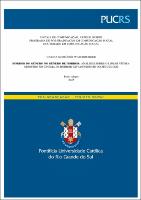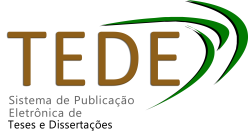| Share record |


|
Please use this identifier to cite or link to this item:
https://tede2.pucrs.br/tede2/handle/tede/11678Full metadata record
| DC Field | Value | Language |
|---|---|---|
| dc.creator | Waschburger, Carina Schröder | - |
| dc.creator.Lattes | http://lattes.cnpq.br/2589780420159507 | por |
| dc.contributor.advisor1 | Gutfreind, Cristiane Freitas | - |
| dc.contributor.advisor1Lattes | http://lattes.cnpq.br/3277381991746025 | por |
| dc.date.accessioned | 2025-06-11T14:56:05Z | - |
| dc.date.issued | 2025-03-25 | - |
| dc.identifier.uri | https://tede2.pucrs.br/tede2/handle/tede/11678 | - |
| dc.description.resumo | A presente tese tem como principal objetivo investigar a representação da mulher como vítima e como monstro no cinema de horror estadunidense da segunda década do século XXI. A partir deste objetivo, buscamos analisar personagens femininas em filmes do gênero, traçando um comparativo entre obras que possuem mulheres nas equipes técnicas principais em contrapartida às que possuem apenas homens, procurando investigar como as diferentes vivências influenciam na representação das personagens dentro da narrativa. Entendemos essa disparidade como informação essencial na análise das personagens femininas, uma vez que vivemos em uma sociedade que prioriza narrativas a partir do ponto de vista masculino, valorizando a jornada do herói enquanto são seus obstáculos que aparentam ser morfologicamente femininos. Entendendo que, especialmente nas últimas décadas, o cinema de horror é um gênero que utiliza as figuras femininas como centro de suas tramas, analisamos a condição dessas protagonistas dentro do que nomeamos de “limiar vítima-monstro”. Tal limiar é constituído como uma zona facilmente transposta pelas mulheres, que transitam entre vítima e monstro ao não conseguir se desvencilhar dos papéis impostos por uma sociedade patriarcal. Partindo do anseio de compreender o paradoxo feminino, analisamos os filmes A Primeira Profecia (The First Omen, Arkasha Stevenson, 2024) e Imaculada (Immaculate, Michael Mohan, 2024), a fim de compreender o papel da mulher em narrativas semelhantes, mas com pontos de vista distintos, sendo o primeiro dirigido e roteirizado por uma mulher, e o segundo por um homem. A análise desta tese intercala imagens dos filmes com as principais emoções associadas ao cinema de horror (medo, raiva e nojo) e qual seu papel em tela com o limiar. Este estudo compreende, por fim, o limiar como um espaço moralmente ambíguo, onde podemos encontrar a figura da bruxa – uma mulher que, em sua recusa a se conformar com definições sociais e morais sobre o que é adequado e esperado para uma mulher, é vista como monstruosa ao mesmo tempo em que é vitimada por essa sociedade patriarcal e pelo próprio Estado que impõe esses padrões estereotipados e pré-definidos. Realizamos a análise desta figura através dos filmes A Bruxa (The Witch, Robert Eggers, 2016) e The Love Witch (Anna Biller, 2016), traçando comparações das duas representações da bruxa, uma em um filme dirigido por um homem e outro por uma mulher, ambos filmes sendo também lançados no mesmo ano. A partir destas análises, foi possível compreender que o limiar vítima-monstro oferece às personagens femininas uma flexibilidade moral poucas vezes concedida a personagens não-masculinos, especialmente quando estas personagens são criadas e dirigidas por alguém que compartilha de seu ponto de vista. Enquanto as produções criadas por homens buscam uma justificativa por trás da monstruosidade feminina, as personagens criadas e dirigidas por mulheres possuem um desenvolvimento que compreende que o monstruoso pode acontecer apesar de sua vitimização de uma sociedade opressora e não somente por causa dele. | por |
| dc.description.abstract | This thesis aims to investigate the representation of women as victims and monsters in American horror cinema during the second decade of the 21st century. To achieve this goal, we analyze female characters in films of the genre, comparing works with women in key technical roles to those with mostly male teams, exploring how different experiences influence the portrayal of characters within the narrative. We consider this disparity essential for analyzing female characters, as we live in a society that prioritizes narratives from a male perspective, valuing the hero's journey while its obstacles appear morphologically female. Recognizing that horror cinema often centers female figures in its plots, we examine the condition of these protagonists within what we named as the "victim-monster threshold." This threshold is characterized as a space easily transpassed by women, who shift between victim and monster as they struggle to break free from roles imposed by a patriarchal society. In our quest to understand the female paradox, we analyze the films The First Omen (Arkasha Stevenson, 2024) and Immaculate (Michael Mohan, 2024) to comprehend the role of women in similar narratives with distinct perspectives, the former being directed and written by a woman and the latter by a man. This thesis interweaves images from the films with the primary emotions associated with the horror genre (fear, anger, and disgust) and their role in relation to the threshold. Ultimately, this study conceptualizes the threshold as a morally ambiguous space where we encounter the figure of the witch — a woman who, in her refusal to conform to societal and moral definitions of what is appropriate and expected for women, is perceived as monstrous while simultaneously being victimized by a patriarchal society and the state that enforces these stereotyped and predefined standards. We analyze this figure through the films The Witch (Robert Eggers, 2016) and The Love Witch (Anna Biller, 2016), drawing comparisons between the two representations of the witch, one in a film directed by a man and the other by a woman, both released in the same year. Through these analyses, we find that the victim-monster threshold offers female characters a moral flexibility rarely granted to nonmasculine characters, especially when these characters are created and directed by someone who shares their perspective. While male-created productions seek justification for female monstrosity, characters created and directed by women develop an understanding that the monstrous can occur despite their victimization by an oppressive society, rather than solely because of it. | eng |
| dc.description.provenance | Submitted by PPG Comunicação Social ([email protected]) on 2025-05-26T23:18:59Z No. of bitstreams: 1 TESE_CARINA - FINAL - revisado.pdf: 3000405 bytes, checksum: d2c68b9c8092bb4505dabb86492511c2 (MD5) | eng |
| dc.description.provenance | Approved for entry into archive by Náthali Aquino ([email protected]) on 2025-06-11T14:43:37Z (GMT) No. of bitstreams: 1 TESE_CARINA - FINAL - revisado.pdf: 3000405 bytes, checksum: d2c68b9c8092bb4505dabb86492511c2 (MD5) | eng |
| dc.description.provenance | Made available in DSpace on 2025-06-11T14:56:05Z (GMT). No. of bitstreams: 1 TESE_CARINA - FINAL - revisado.pdf: 3000405 bytes, checksum: d2c68b9c8092bb4505dabb86492511c2 (MD5) Previous issue date: 2025-03-25 | eng |
| dc.description.sponsorship | Coordenação de Aperfeiçoamento de Pessoal de Nível Superior - CAPES | por |
| dc.format | application/pdf | * |
| dc.thumbnail.url | https://tede2.pucrs.br/tede2/retrieve/193940/TESE_CARINA%20-%20FINAL%20-%20revisado.pdf.jpg | * |
| dc.language | por | por |
| dc.publisher | Pontifícia Universidade Católica do Rio Grande do Sul | por |
| dc.publisher.department | Escola de Comunicação, Arte e Design | por |
| dc.publisher.country | Brasil | por |
| dc.publisher.initials | PUCRS | por |
| dc.publisher.program | Programa de Pós-Graduação em Comunicação Social | por |
| dc.rights | Acesso Aberto | por |
| dc.subject | Cinema de Horror | por |
| dc.subject | Feminismo | por |
| dc.subject | Monstruoso-feminino | por |
| dc.subject | Limiar | por |
| dc.subject | Emoções | por |
| dc.subject | Horror Cinema | eng |
| dc.subject | Feminism | eng |
| dc.subject | Monstruous-feminine | eng |
| dc.subject | Threshold | eng |
| dc.subject | Emotions | eng |
| dc.subject.cnpq | CIENCIAS SOCIAIS APLICADAS::COMUNICACAO | por |
| dc.title | Horror do gênero no gênero de horror : análises sobre o limiar vítima-monstro no cinema de horror estadunidense do século XXI | por |
| dc.type | Tese | por |
| dc.restricao.situacao | Trabalho não apresenta restrição para publicação | por |
| Appears in Collections: | Programa de Pós-Graduação em Comunicação Social | |
Files in This Item:
| File | Description | Size | Format | |
|---|---|---|---|---|
| TESE_CARINA - FINAL - revisado.pdf | CARINA_SCHRODER_WASCHBURGER_TES | 2.93 MB | Adobe PDF |  Download/Open Preview |
Items in DSpace are protected by copyright, with all rights reserved, unless otherwise indicated.




